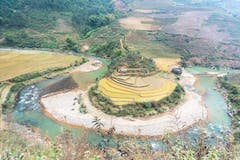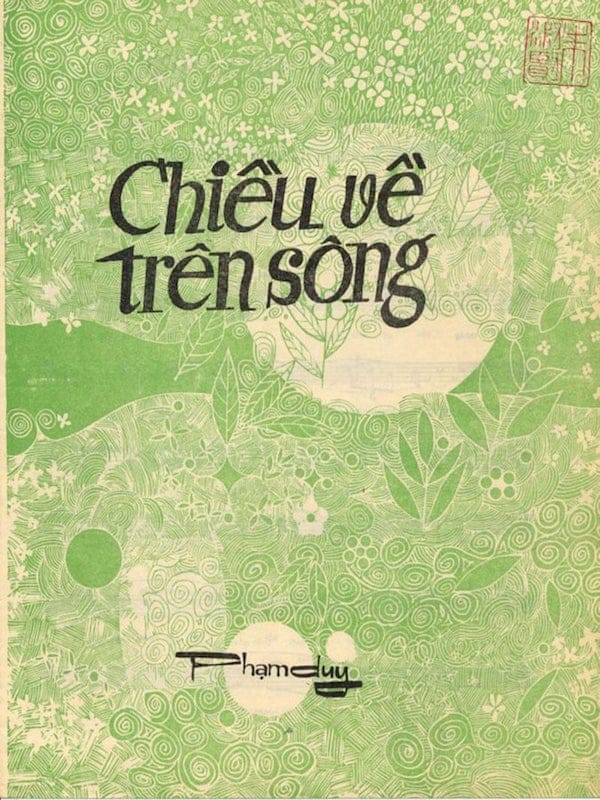 rossed a major milestone in paddling: 10 kilometers roundtrip finished in 2h 15′ (including resting time), speed – made – good averages out at 4.4 kilometre per hour (km/h), or almost 2.4 knot. That is already better than the baseline usually applied for casual paddlers at about 3.3 km/h, but much behind that of frequent paddlers, they can easily make it at 5 ~ 6 km/h. Of course, velocity depends on various other factors, most importantly the boat and paddle designs, which I currently don’t have much choice.
rossed a major milestone in paddling: 10 kilometers roundtrip finished in 2h 15′ (including resting time), speed – made – good averages out at 4.4 kilometre per hour (km/h), or almost 2.4 knot. That is already better than the baseline usually applied for casual paddlers at about 3.3 km/h, but much behind that of frequent paddlers, they can easily make it at 5 ~ 6 km/h. Of course, velocity depends on various other factors, most importantly the boat and paddle designs, which I currently don’t have much choice.
Chiều về trên sông - Thái Thanh ►
About range, that’s still not half of my ultimate (projected) target somewhere around 25 km, which approximates a typical whole – day canoe camping trip. Still having a very large gap to try and overcome! Paddling for me is not racing, and like they often say: it’s a marathon, not a sprint!
, but you need some measures to evaluate your performance progress anyhow. As I paddle on, I’ve learned some below lessons.

Most beginners like me are low – angle paddlers, naturally. That is arms rarely raise up to shoulder level, the paddle’s shaft is more often in a horizontal position, the “angle of attack” at which the paddle’s blades enter water is much smaller than 90°. In contrast, high – angle paddling requires keeping ams at shoulder level, paddle’s blades penetrate water in a near – vertical manner. For beginners, the first approach cause less tiredness: arms don’t need to be kept high, and movements are easier.
But high – angle is more efficient: first, blades enter water at steep angle, providing more propulsion. Second, blades are nearer to the hull, producing less turning moment and more forward – pushing torque. And third, most importantly, not just your arms pull and push the paddle, but the rotation of your torso brings much force into action, and helps relieving stresses to your hands and arms. So, I’ve tried overcoming the fatigue of high – angle paddling, in the long run, it will make benefits.

Paddling a boat sometimes reminds me of the Latin phrase: Mobilis in mobili
, yes you may have remembered it, captain Nemo’s personal motto in Jules Verne’s famous novel: Twenty Thousand Leagues Under the Sea, moving in a moving environment, moving amidst mobility… 😀 The wind, the wave, currents, all affects your rowing, sometimes you go along the current, sometimes against it, sometimes with the aid of winds and sometimes, winds are your enemy.
And the waves too, on the rivers where I go paddling, waves are mostly under 1 foot high, upto 2 feet in the wind gusts, not enough to pose any threat to the boat’s stability, but can make lots of troubles in keeping up a steady course. Sometimes, the current, wind and waves, all at the same time, corporately and deliberately push me off course, sometimes I could hardly make an advance at all, and it turned out to be a real fight in which I need to keep my stamina over a long distance and over extended period of time.

Some of my lessons learned: don’t put too much effort into each paddling strokes, perform strokes gently in a smooth rhythm. Don’t paddle in too shallow water (less than 1 ~ 1.5m), that will considerably reduce boat speed by 1/4 ~ 1/3. (I don’t really understand the physics of this fluid – flow dynamics though). Don’t try to perform many corrective strokes: sometimes the boat is not on an intended heading (e.g: there’s usually some flow turbulence where river changes its direction, or where river’s branches join…)
And you would try to correct it by adding more strokes on one side, it’s not the right way. Instead, just paddle in balance, then offset the heading by a small angle to compensate the dragging effects. That will eventually make your boat’s path slightly zig – zag, but in reality, a direct line is not always the shortest path between 2 points, it’s so in the 2D Cartesian space (e.g: map) only, not in a higher – dimensional space where we take other factors (current, wind…) into account.

 piece of music for working time listening… Mất một số kha khá thời gian để hiểu ra nhận xét sau của NS Phạm Duy về nhạc sĩ tiền bối Dương Thiệu Tước: khi ông viết theo điệu Tây, nhạc rất là Tây, khi ông viết theo kiểu Ta, điệu lại quá là Ta. Nói một cách khác, ông (DTT) vừa Tây hơn tất cả chúng ta, và đồng thời, lại Ta hơn thảy chúng ta.
piece of music for working time listening… Mất một số kha khá thời gian để hiểu ra nhận xét sau của NS Phạm Duy về nhạc sĩ tiền bối Dương Thiệu Tước: khi ông viết theo điệu Tây, nhạc rất là Tây, khi ông viết theo kiểu Ta, điệu lại quá là Ta. Nói một cách khác, ông (DTT) vừa Tây hơn tất cả chúng ta, và đồng thời, lại Ta hơn thảy chúng ta.

 hích nghe chữ
hích nghe chữ 
 hừng này tạm đủ như một lời giới thiệu ngắn gọn về giọng ca Thái Thanh, hơn 300 ca khúc của nhiều nhạc sĩ khác nhau: Phạm Duy, Phạm Đình Chương, Dương Thiệu Tước, Hoàng Trọng, Văn Phụng, Văn Cao, Lê Thương, Trịnh Công Sơn… Các ca khúc được xếp theo thứ tự ABC để tiện tìm kiếm. Những tựa in đậm là những ca khúc tôi thích và thường nghe. Chất lượng âm thanh không đồng nhất, tốt có, kém có, nguyên bản nhiều, remixed cũng lắm. Chất lượng âm nhạc… cũng thế!
hừng này tạm đủ như một lời giới thiệu ngắn gọn về giọng ca Thái Thanh, hơn 300 ca khúc của nhiều nhạc sĩ khác nhau: Phạm Duy, Phạm Đình Chương, Dương Thiệu Tước, Hoàng Trọng, Văn Phụng, Văn Cao, Lê Thương, Trịnh Công Sơn… Các ca khúc được xếp theo thứ tự ABC để tiện tìm kiếm. Những tựa in đậm là những ca khúc tôi thích và thường nghe. Chất lượng âm thanh không đồng nhất, tốt có, kém có, nguyên bản nhiều, remixed cũng lắm. Chất lượng âm nhạc… cũng thế!








 ne miscellaneous linguistic notice, except for things borrowed from Chinese, which is largely unpopular to most people in daily, pragmatic uses, the Vietnamese language, in essence, is strictly postpositive, that is an adjective must be placed after a noun / pronoun that it modifies. So the following examples which are prepositive, are extremely rare, to the point of… bizzare, but they’re also very interesting, note the underlined, bold phrases. Add more examples to the list if you would find one! 😀
ne miscellaneous linguistic notice, except for things borrowed from Chinese, which is largely unpopular to most people in daily, pragmatic uses, the Vietnamese language, in essence, is strictly postpositive, that is an adjective must be placed after a noun / pronoun that it modifies. So the following examples which are prepositive, are extremely rare, to the point of… bizzare, but they’re also very interesting, note the underlined, bold phrases. Add more examples to the list if you would find one! 😀 hía trước là con đường… hành trình tiếp tục theo đường Trường Sơn, từ Khâm Đức (Phước Sơn, QN), vượt đèo Lò Xo chạy kế bên khu bảo tồn thiên nhiên Ngọc Linh là qua địa phận tỉnh Kontum. Con đèo dài và khá khó đi, dưới chân đèo, một chiếc 50 chỗ cháy trơ trụi còn đang bốc khói nghi ngút, các xe đi ngược chiều cũng toả ra một mùi bố thắng khét lẹt. Tuy nhiên, đã đi qua những cung đường Tây Bắc khó khăn hơn nhiều nên đèo Lò Xo cũng không phải là vấn đề gì quá lớn.
hía trước là con đường… hành trình tiếp tục theo đường Trường Sơn, từ Khâm Đức (Phước Sơn, QN), vượt đèo Lò Xo chạy kế bên khu bảo tồn thiên nhiên Ngọc Linh là qua địa phận tỉnh Kontum. Con đèo dài và khá khó đi, dưới chân đèo, một chiếc 50 chỗ cháy trơ trụi còn đang bốc khói nghi ngút, các xe đi ngược chiều cũng toả ra một mùi bố thắng khét lẹt. Tuy nhiên, đã đi qua những cung đường Tây Bắc khó khăn hơn nhiều nên đèo Lò Xo cũng không phải là vấn đề gì quá lớn.











 uôi theo đường HCM, từ Hà Tĩnh, ngã ba Đồng Lộc, Tân Ấp, vượt đèo Đá Đẽo, đến Phong Nha, Quảng Bình. Trời đã về chiều nên không đi trên nhánh Tây của đường HCM, một đoạn 250 km không có lấy một cụm dân cư hay cây xăng nào, đi theo nhánh Đông, về đến Cam Lộ, Quảng Trị lúc 10h tối do mải mê chụp ảnh dọc đường. Đoạn đi qua vườn quốc gia Vũ Quang, khu bảo tồn thiên nhiên Phong Nha, Kẻ Bàng, nhiều nơi vẫn còn là rừng nguyên sinh trông rất hấp dẫn.
uôi theo đường HCM, từ Hà Tĩnh, ngã ba Đồng Lộc, Tân Ấp, vượt đèo Đá Đẽo, đến Phong Nha, Quảng Bình. Trời đã về chiều nên không đi trên nhánh Tây của đường HCM, một đoạn 250 km không có lấy một cụm dân cư hay cây xăng nào, đi theo nhánh Đông, về đến Cam Lộ, Quảng Trị lúc 10h tối do mải mê chụp ảnh dọc đường. Đoạn đi qua vườn quốc gia Vũ Quang, khu bảo tồn thiên nhiên Phong Nha, Kẻ Bàng, nhiều nơi vẫn còn là rừng nguyên sinh trông rất hấp dẫn.


















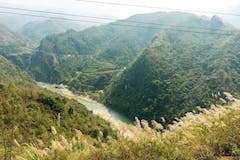
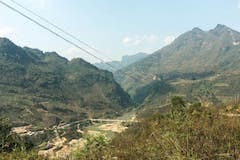



 uãng đường này đi sát với biên giới TQ, nhiều đoạn quốc lộ 4D ở lưng chừng núi, ngay dưới chân núi đã là đường biên. Đây là một cung đường khó khăn, đường đi rất xấu, nhiều đoạn đang xây dựng dở dang, taluy cao ngút tầm mắt, nhiều đoạn dốc dể trên 30%. Cứ nhìn mức độ tiêu hao xăng của xe là biết đường xấu hay tốt. Con ngựa sắt đến tận giờ vẫn là người bạn trung thành, hoạt động trơn tru không có vấn đề gì lớn ngoài đôi lần hơi khó khởi động do thời tiết quá lạnh.
uãng đường này đi sát với biên giới TQ, nhiều đoạn quốc lộ 4D ở lưng chừng núi, ngay dưới chân núi đã là đường biên. Đây là một cung đường khó khăn, đường đi rất xấu, nhiều đoạn đang xây dựng dở dang, taluy cao ngút tầm mắt, nhiều đoạn dốc dể trên 30%. Cứ nhìn mức độ tiêu hao xăng của xe là biết đường xấu hay tốt. Con ngựa sắt đến tận giờ vẫn là người bạn trung thành, hoạt động trơn tru không có vấn đề gì lớn ngoài đôi lần hơi khó khởi động do thời tiết quá lạnh.








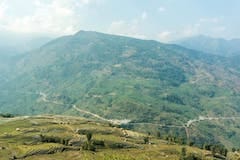


 ơn Tây đi Yên Bái: theo QL32 chạy dọc triền đê sông Thao lên đến tp. Yên Bái, qua huyện Trấn Yên là đã vào vùng trung du đồi núi trập trùng. Ghé qua Suối Giàng, ở độ cao 1400 m, quê hương của giống chè Shan Tuyết, “vua của các loại chè” Việt Nam, những gốc chè cổ thụ hàng trăm năm tuổi, vừa vòng tay 1, 2 người ôm trồng tít mãi trên những đỉnh núi cao, những đồi chè xanh ngát trập trùng. Rồi chạy tiếp đến Nghĩa Lộ, Mường Lò, cánh đồng (“mường”) lớn thứ hai vùng Tây Bắc.
ơn Tây đi Yên Bái: theo QL32 chạy dọc triền đê sông Thao lên đến tp. Yên Bái, qua huyện Trấn Yên là đã vào vùng trung du đồi núi trập trùng. Ghé qua Suối Giàng, ở độ cao 1400 m, quê hương của giống chè Shan Tuyết, “vua của các loại chè” Việt Nam, những gốc chè cổ thụ hàng trăm năm tuổi, vừa vòng tay 1, 2 người ôm trồng tít mãi trên những đỉnh núi cao, những đồi chè xanh ngát trập trùng. Rồi chạy tiếp đến Nghĩa Lộ, Mường Lò, cánh đồng (“mường”) lớn thứ hai vùng Tây Bắc.









